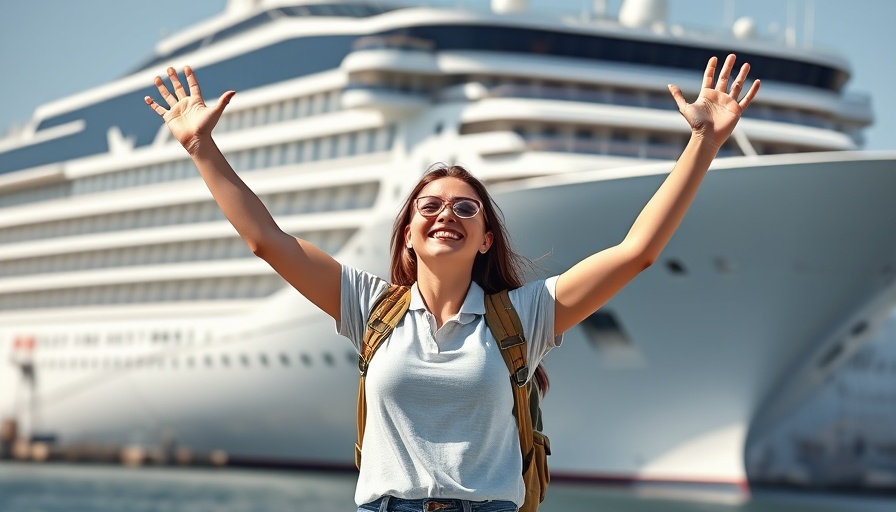
Navigating Change: The Shifting Landscape of Cruise Tourism
As we sail into a new era of travel, the majestic ports of Europe are embarking on a transformative journey. The once-celebrated cruise ships, symbols of luxury and adventure, are now being scrutinized under the lens of sustainability. Increasingly, cities such as Venice, Amsterdam, and Barcelona are taking bold steps to combat the mounting pressures of overtourism, as they seek to strike a balance between economic prosperity and the well-being of local communities.
The Overtourism Dilemma: A Growing Concern
Overtourism has emerged as a pressing challenge for Europe’s iconic destinations. For instance, Amsterdam, known for its picturesque canals, encounters major difficulties with overcrowded streets. In 2024, over 30 million cruise passengers flocked to European ports, dramatically raising the tourist-to-resident ratio and placing a strain on already limited infrastructure. Local inhabitants express rising discontent with the surge, sparking protests and calls for change.
Local vendors, such as one in Trieste, echo this sentiment; they rely heavily on cruise passenger spending yet are keenly aware of the impact on their community. "These visitors from the pier? We depend on them," they might say, yet the discontent is palpable. Overall, while cruise lines contribute significantly to local economies through port fees and passenger spending, many question whether this economic benefit offsets the ensuing overload on public resources and infrastructure.
Venice's Lagoon Lockdown: Balancing Tourism and Environment
Venice, a jewel in Italy's crown, illustrates the fragile balance between tourism and environmental protection. In response to the devastating effects caused by large vessels on the iconic lagoon, the city has imposed strict bans on cruise ships exceeding 25,000 gross tons from entering sensitive areas like the Giudecca Canal and San Marco Basin since August 2021. In efforts to restore the lagoon's health, ships have been rerouted, aiming to preserve its beauty for future generations.
Further restrictions are also on the horizon, such as limiting ship traffic by 20% and introducing entry fees. The effects of these regulations are evident, with a 15% decrease in large-ship visits noted in the 2025 season. However, the challenge remains: how can Venice sustain its economy while protecting its delicate ecosystem?
Amsterdam's Strategy: A Sustainable Shift Ahead
Amsterdam is firmly focused on cutting down cruise ship traffic, dropping the number of cruise calls from 190 to just 100 annually by 2026. By relocating the Passenger Terminal Amsterdam away from the city center, the port aims to diminish tourism's heavy footprint on local life. This transition is part of a larger, eco-conscious initiative where all cruise ships must soon utilize shore-side power to reduce emissions, showcasing a commitment to sustainability.
Through such measures, Amsterdam hopes to preserve its cultural heritage while still reaping the economic benefits from tourism, ultimately paving the way for a more balanced approach.
Barcelona and Cannes: Regulating Cruise Sizes
Similar trends can be observed in Barcelona, where city authorities are enforcing a limit on cruise ships from 2026 onwards. By reducing the number of berths from seven to five and cutting overall capacity, city planners aim to curtail the influx of visitors while preserving the essence of the vibrant city. Histories and legacies must be honored as travel adapts to maintain sustainable practices.
Meanwhile, Cannes has also initiated a ban on large cruise ships, permitting only those with fewer than 1,000 passengers into the harbor. The city's strategy focuses on managing the crowds and their impact on local life while enhancing the aesthetics and quality of the tourist experience.
The Future of Cruise Tourism: A Hopeful Outlook
As more European cities step up to address the challenges posed by overtourism, travelers may need to reconsider their cruising habits. Gone are the days when larger cruise ships ruled the seas; the future beckons smaller, more sustainable vessels that prioritize the environment and community wellbeing. This new direction is vital for ensuring that vibrant cultures and breathtaking destinations can be enjoyed without the debilitating effects of tourism.
In the face of changing tides, the choices travelers make present opportunities for more responsible and ethical explorations. The success of these evolving regulations will hinge not only on the actions of cities but also on the commitment of visitors to travel more sustainably and mindfully, championing the cause of local communities and embracing the beauty of a well-preserved Europe.
As travelers seek adventure, let us all play a part in respecting the delicate balance that needs to be maintained when exploring our world's treasures. Together, we can embark on this hopeful journey towards sustainable tourism, where both people and places thrive.
 Add Row
Add Row  Add
Add 




Write A Comment